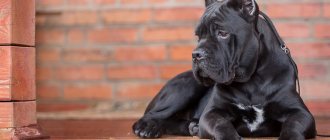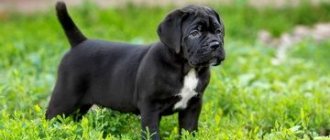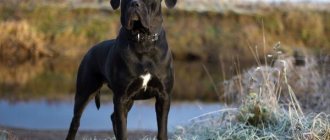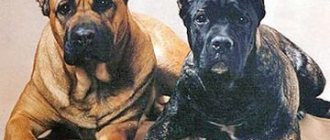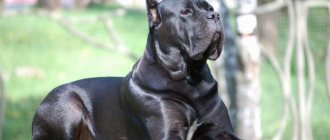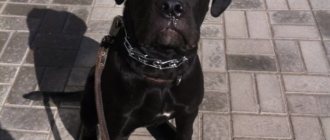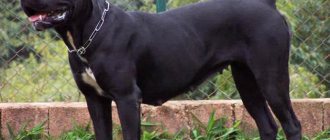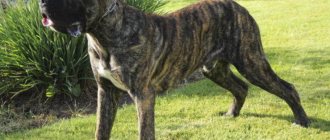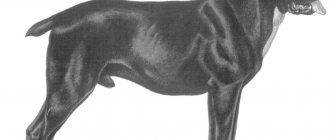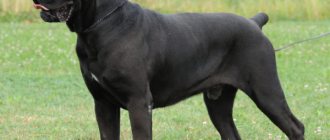When a Cane Corso appears in the house, training and raising the dog plays an important role.
This dog breed dates back to Ancient Rome, and at the genetic level it has a tendency towards guarding and protective functions.
The Cane Corso belongs to the category of large, strong dogs with developed muscles and increased physical activity.
With proper upbringing, she will become a reliable protector for the whole family.
The need for training
Cane Corso are by nature intelligent, good-natured dogs that are great with children. However, like people, animals need gradual development of abilities, i.e. in education and training.
Unlike humans, their behavior is based on instincts.
In the process of evolution of the Cane Corso breed, it received a lot of positive reflexes , which gradually transferred to the genetic level .
In order for them to become the norm of dog behavior, they must be developed as much as possible, suppressing negative and unwanted manifestations.
For a dog, training is training, i.e. development of the necessary instincts.
Constant education and proper training should become an integral part of a pet's life . Only in this case can you raise an intelligent and well-mannered dog.
The Cane Corso is a large dog, and its appearance can frighten people, and incorrect behavior causes panic. Obedience, calmness and a sense of proportion are especially important for this breed.
It is necessary to develop a reserved attitude towards other animals.
History of the Cane Corso breed
Cane Corso is one of the most ancient breeds and belongs to the Molosser group. Some researchers believe that other breeds originated from it. Others call the ancestors of these dogs Tibetan Great Danes. The first historical mentions of such large dogs and their images are found in documents dating back to the times of the Roman Empire.
Such dogs have served man for a long time. In addition to participating in gladiatorial battles, they guarded houses, went hunting and even took part in war. They were highly valued and expensive. In the Middle Ages, these large Italian dogs were used to herd wild animals, herd livestock, and protect homes.
For two thousand years, these dogs have not changed, they were valued and were not crossed with others. But in the 20th century, their number began to decline; the Second World War brought the breed to the brink of destruction. Only in the 80s did its revival begin. D. Nizzoli collected the remaining representatives of the breed. The Cane Corso or Italian Mastiff was officially recognized in 1996. The breed standard described its specific traits that distinguished it from other mastiffs. Now this breed is popular all over the world.
Interesting facts about the Cane Corso can be learned from the video:
Video: Cane Corso - Interesting facts about the breed
Secrets of education
By nature, Cane Corso dogs are highly trainable. Taking into account the psychology of the animal and its individual characteristics, Cane Corsos are happy to follow commands and are prone to obedience.
That is why training can be carried out by the owner himself, if he has sufficient patience and willpower.
At what age should training begin? Raising a dog must be carried out from the first day the puppy appears in the house. The ideal time to start training is 3 months of age, but even before that the pet should be accustomed to the collar and respond to its name. It is advisable to toilet train. Serious professional training is most effective when the dog reaches 3 years of age.
CAREFULLY!
If for some reason the initial stage of education is overdue, then you should not despair.
In principle, the Cane Corso can be trained at any age. You just need to take into account that the older the dog is, the more difficult and longer the training course takes.
Where does education and training begin?
First of all, the following issues need to be resolved:
- Prepare and accustom the dog to a training choke collar with a leash. It is composed of ringed metal links. The size of the collar should exceed the head circumference by 25-30 mm. The leash is made of leather and has a width of 20-25 mm and a length of 2 m. The training collar allows you to control the behavior of your pet, because tugging on the leash causes the loop to tighten, and the dog immediately feels the owner’s reaction.
- A stimulating treat. The first lessons should be based on encouraging the right actions, and a tasty treat is a great incentive. The owner must choose what his pet loves most.
- Choosing a place to study. It should be absolutely safe for the puppy when running and jumping. No one and nothing should distract him from his studies. It is best to choose a place that the dog has already explored. In a new place, unknown smells will constantly distract her. Sniffing will take a long time.
- Providing psychological contact. During training, the owner must remain alone with the pet. Any right actions must be accompanied by affection and kind words.
When conducting training, you need to choose the right voice intonation.
Orders are given in a calm but stern voice. A prohibition requires a demanding, threatening intonation. All encouraging and approving messages are made in a cheerful, gentle voice.
Voice commands are accompanied by gestures, and both must be clear and confident.
The optimal conditions for conducting classes are considered to be an air temperature of about 13-17 degrees in the absence of precipitation and strong wind.
It is better to conduct training in the morning and evening before feeding the dog. You cannot train a sick pet, a nursing dog, or a female dog in heat.
During training, the dog must be given rest . It is recommended to alternate exercises with game elements and free movement.
Shepherd dogs
Digger had everything a good dog should have: a home, a rug, a full bowl and an owner who loved, pampered and exercised. But one day the woman died, and the dog was left at the mercy of her son, who suffered from a whole bunch of mental disorders. Digger was beaten daily, cigarette butts were put out on him, and knitting needles were stuck into him. The dog was literally rotting alive and waiting to die. Fortunately, there were people who scoured the Internet and came across the “Ovcharka.Life” team. With the help of the police, Digger was taken away; he, barely alive, was loaded into a car and immediately taken to the clinic. When the doctors who treated him left the operating room, they cried. Digger was treated, fattened, rehoused, and now he is doing well.
Lyubov Lebedeva,
leader of the Ovcharka.Life team
“I have been rescuing shepherd dogs for seven years now,” says Lyubov Lebedeva, leader of the Ovcharka.Life team. “At first I came to help another breed team, and then I spun around and ran off on my own, along with a group of girls. Strength and opportunities appeared, the first volunteers came, and this is how “Ovcharka.Life” was formed. We have a wide variety of people, mostly those who helped shepherds as part of other breed teams. We are primarily engaged in rescuing German and East European shepherds, but in general we have an unspoken rule that if a shepherd and a non-shepherd are running nearby on the street, then we take both. No matter how much we are fans of shepherd dogs, if there is a Labrador mix or an old Alabaika with a bleeding wound on the street, they will still go to the team. We currently have about 115 dogs under our care. We don’t have our own foster care; we rent enclosures at five points in different parts of the Moscow region.
A shepherd can end up on the street in a variety of ways. Mostly, their owners abandon them: some are unable to feed them, others have failed to raise them. It happens that people get divorced, and neither of them needs a dog; there are cases of outright canine stupidity. Or here’s another option for you: buy a puppy and play with it. Since the beginning of January, we already have two such grown-up puppies - one was dropped out of the car on the highway, and the second was simply taken to the village. For many people this is normal now.
The pandemic also played a role - when self-isolation began, they started calling us and asking for a dog so that they could leave the house. To the question “What will happen to her later?” These “kind hands”, as a rule, answered: “Well, we’ll leave it at the dacha or somewhere else in the afternoon.” In addition, many have lost their jobs. Now all the breed teams are working hard because people are going crazy. Yorkshiremen began to be thrown out onto the street with the words “We have nothing to feed him” - how does that even happen? Hey, people, this is a Yorkie, he eats no more than a cat! Dogs with scalped wounds and other traces of sadistic violence came in a shoal. Or they call us: “So, you have three hours to pick him up, time has run out, otherwise we will put him to sleep. Would you like us to send you a video of how we will kill him?” So now we are trying to respond as quickly as possible.
Our work scheme is very simple: we receive a message about a dog and pick it up from the street. We don’t have our own catchers, except that sometimes we hire outsiders for money if the dog is aggressive or timid. Some are brought and given to us by the owners themselves, sometimes we take those who were brought to the veterinary clinic for euthanasia, it happens that dogs are written off from service, and these are not always older dogs; among today’s “Germans” the loss of working qualities can occur in at any age."
Various ways
Cane Corso training can be done in various ways.:
- Taste-enhancing technique. The method is used often and is based on food motivation. For the correct action, the dog receives a tasty treat. The lesson is recommended to be carried out 4-5 hours after feeding. The disadvantage is that not all skills are taught through treats.
- Mechanical technique. It is based on encouraging stroking or forced influence (jerks with a leash, hand pressure, the influence of a training collar). It is used mainly when training with adult animals.
- Contrast method. It combines elements of the 2 previous methods. A treat is used as a reward, and in case of incorrect behavior, mechanical stimuli are used.
- Game method. The main advantage is the reduction of nervous stress on a young dog. Disadvantage: low efficiency. The technique is considered auxiliary and is usually used in combination with other methods of training.
- Imitative way. It is based on the instinct to imitate the behavior of other dogs. The greatest effect is obtained when training in the presence of the mother, from whom the puppy takes an example. The technique can also be used in collective training. It is recommended to use as an additional method in combination with other methods.
- Push method. Its essence is to force the action to be performed using hands or a leash. It can be used at the initial stage of puppy training and should not cause pain.
The choice of training method depends on the dog’s age, its individual characteristics, and the state of the nervous system. When training on your own, it is better to coordinate it with an experienced dog handler.
Expert opinion
Kozhevin Semyon Kirillovich
Expert dog handler.
“An experienced dog trainer is able to accurately determine the most effective way to train a Cane Corso. In early puppyhood, these dogs are easy to train when using a contrasting technique in combination with play elements. This breed is characterized by increased playfulness, which allows you to captivate the puppy and include educational elements in the game. The dog quickly gets used to commands, and correct actions must be rewarded with treats.”
Owner experience
Do not train your baby if you are in a bad mood, dogs are excellent psychologists, and your depression can rub off on them. Both puppies and adults copy their owner in everything; a loving dog will try to be with you.
Dogs are able to find a special approach to everyone in order to satisfy their whims. There are no two identical puppies or adult pets; each has a different character and habits.
His character in the future depends on training. It depends on you whether your pet will grow up to be a cheerful and devoted friend or a nervous, unsociable creature.
Getting Some Skills
One of the first skills to teach your Cane Corso puppy is toilet training.
It is too early to accustom a small pet to the outdoor toilet, and therefore he settles down at home.
To do this, you can use a tray with filler, newspapers or a disposable diaper. They should always be located in one place, and the puppy should do “his business” only here.
In order to toilet train your pet, you need to be patient - this process is quite long . First of all, in the apartment where the puppy has settled, it is better to remove carpets and rugs from the floor - they attract the pet and retain the smell for a long time.
When he relieves himself, he is guided by instincts, and therefore he usually chooses a certain place. This is where the toilet should be placed.
It will be much easier to accustom the animal to such a place.
As a rule, such places are located next to the door, under the window, in the corner or on the balcony . It should be provided with free access at any time and not frighten the pet while relieving itself.
If the puppy has chosen an unsuitable place, then it must be weaned from it. To do this, substances are used that repel the dog.
You can use the Antipis tool . A dog will never defecate where food is located. This option can also be used.
Team "Place"
The next important step in raising a puppy is the execution of the “Place” command.
This command carries two meanings . At home, this is how the dog is instructed to go to its bedding and not disturb people. The pet usually quickly understands what they want from him and leaves with resentment for a while. Then he leaves the litter, but no longer gets bored.
IMPORTANT!
On the street the meaning of the command is different. The “place” becomes the object or area to which the owner points.
This command is taught in this way. At home, you can use a taste-enhancing method.
After giving the “Place” command, you should lure the puppy onto its bedding and reward it with a treat. After repeated repetition, this action will become a reflex.
On the street, it is worth thinking about the special skills of the dog - guard . To do this, place a bag or backpack in a certain place that is well known to the animal.
Naturally, the dog’s guard instinct is triggered, and it lies down or sits next to him. Then the owner moves a few meters to the side and calls her to him.
After that, he points to the thing and orders the dog “Place”, and it comes back . After some time, things no longer lie down, but simply pointing to an object is enough. The correct action of the pet should be rewarded.
Alabai
Bella, white as snow, was bought from a gypsy camp where she was beaten. When volunteers came for her, she crawled towards them on her belly, closing her eyes and pressing her whole body to the ground. She was trembling with fear, she thought that now she would be hit again just like that, for no reason. She even cried quite humanly, with squeaks and tears, but these new people did not beat her, but began to stroke her, called her a smart girl and a beauty, and then loaded her into a car and drove her somewhere. As a result of the bullying Bella suffered, she lost an eye, but this did not stop her from settling into a new family in less than a year. She became a happy Alabai, a guardian of her own yard, a friend to a mongrel terrier and an angry white cat.
Tatyana Chertovitskaya,
coordinator of the Alabai Help team
“We have an overproduction of Asians,” sighs Tatyana Chertovitskaya, coordinator of the Alabai Help team. — Keep your fingers crossed: they are the first in the number of litter activations in the Russian Cynological Federation, and in addition to the RKF, we also have SCOR (Union of Cynological Organizations of Russia) and “Kind World”, and there is also wild breeding, and “aboriginals” are also brought here from the mountains and from Central Asia. Here they actively reproduce without any accounting. Moreover, everyone in the know understands that breeding Alabais does not bring profit - they cost five rubles a bunch on Avito. But citizens see a puppy on the Internet for 45 thousand and think: “Yeah, now I’m going to get rich.” And they breed just anyone with anyone from the back alley, without receiving an assessment at the show, without doing genetic tests, and when it turns out that no one will take such puppies for even an A, and they demand to eat every day, they are put out on the street.
As a result, we see more and more sick dogs every year. We recently had a puppy on our team, 9 months old, branded - and he has dysplasia in the last stage! How is this possible if, according to the current rules, both parents had to pass tests for dysplasia to be allowed to breed? And like this. There are a lot of dogs with cancer, and this didn’t happen until 2022, but now there are more and more of them.
At the moment, “Alabai Help” has around 80 dogs under its supervision, but we are not the only team in Moscow that deals with CAO, so you can assess the scale of the tragedy yourself. And we also had to reduce the number of possible “incoming” ones, otherwise we had 110 or 115. By the way, we had to, precisely because of the abundance of sick dogs, there is not enough money for treatment. Sometimes we receive from 10 to 20 dogs a month.
We collect most of the dogs, of course, from the region, where they are bred in huge quantities to protect industrial zones, parking lots and summer cottages. In Moscow itself, they come across much less often - over the past two months, only one male dog was taken from Leninsky Prospekt. In such cases, we always cover the entire area with advertisements, but the owners rarely respond. Even less common are breeders who are ready to take their “babies” back.
Before giving a dog away, we always check the living conditions. We won’t let you put it on a chain, in an area with a flimsy picket fence, or in an open field. Then, of course, there is an interview: how ready a person is for just such a dog and what is on his mind. Those who have serious intentions are ready to listen to advice, come several times to see one dog, and in general their attitude is immediately visible. And then a citizen declares: “Give me a bigger breed, a fatter one and a stronger one,” and it immediately becomes clear that he needs the Alabai in order to assert himself at his expense. However, he has neither experience in keeping this breed nor understanding of it. One of them told me for a long time that a dog is an inanimate object, because scientists, you see, have proven that it does not have a soul. I listened to him and calmly said: “The exit is there, and forget about our existence.” A separate task is how to weed out those who take dogs for fighting, zoo sadists and outright crazy people. For this, we have a double interview system, there are inter-team blacklists with addresses, phone numbers and photographs.
Older dogs - in the case of Alabais this is over six years old - almost never leave us. As far as I can remember, I managed to find only three people in the entire time. This is probably a manifestation of human selfishness: “She won’t live with me for long, 4-5 years, and then I’ll lose her, and it will hurt me again.” The fact that after five years an Alabai cannot be taught anything is a myth; I myself had an age-related refusal, so I know. There are also outright spiteful people who attack everyone except the volunteers they know. I will give such a dog either to a serious and proven security company, or to a truly professional dog handler. In general, when I show dogs, the first thing I do is talk about all their shortcomings, draw the worst scenarios so that the applicant understands what he will encounter and is prepared for anything in advance. It’s easier for me, I don’t want our charges to come back in two months. It’s better for the applicant to be scared, honestly admit to himself that he won’t be able to cope with this dog, and take something simpler or without alabai at all - it will be better for everyone.”
Features of executing various commands
When training a puppy, it is important to teach a few basic commands.:
- "To me" . This is a basic command that a puppy learns to use immediately after learning its name. To present it, the dog’s name is clearly stated, and then pronounced in a demanding tone, “Come to me.” At the beginning of training, you should show your pet a treat, which will make him want to follow the command.
- "Ugh" . The command prohibits lifting anything. When teaching, a mechanical method is used. Food is placed on the ground (floor), but when the dog tries to pick it up, a command is pronounced and a prohibiting action is carried out - a tug on the leash, tightening the collar loop, a light slap on the face with a newspaper or a fly swatter on the head. The action must indicate the existence of danger posed by the object.
- "Near" . With this command, the puppy must stand close to the owner on the left. When training the puppy, the correct execution of the command is indicated with the help of a leash, and after its execution, he is rewarded with a treat.
- "Sit" . This command is duplicated by raising the palm to chest level, while the arm is moved to the left side. When training with your fingers, the dog's pelvic area (lower back) is pressed. With such pressure, the animal’s instinct is triggered, and it sits down. Don't forget about encouragement.
- "Lie" . For a guard dog, this command is important. In order for the puppy to comply with the command, you need to press with your hand in the area between the shoulder blades. After execution - an incentive.
- "Exposure" or "Wait" . The command can be performed while standing, lying down or sitting. In the first case, the dog must remain in a given position for at least 10-15 seconds, and in the second - up to 0.5 hours. Compliance is achieved by rewarding with a treat. At first, the owner does not leave the dog’s visibility, but gradually disappears as the interval of absence lengthens.
- "Give" . Initial exercises are carried out with a puppy toy. After pronouncing the command, the toy is taken from the puppy’s mouth, and his attention is diverted to another object. Action is encouraged. Skills are reinforced with food (a bowl of food, a bone). If the puppy shows aggression, it is recommended to apply pressure with your hand in the area between the shoulder blades, forcing him to lie down. With such training, it is important that the dog understands who is “boss” in the house. She must give away any item.
- "Aport" . Classes to master this command are held outside the home. During the first “lessons,” a favorite dog toy is used. She rushes, then the puppy runs and grabs her. Next the command “Come to me” sounds, and after its execution - “Give”. In subsequent classes, you can use any other items. Usually dogs engage in such training with pleasure, because... it's very game-like.
- "Face" . This team should be the final one in training. It is only permissible for an obedient dog, because... can teach unexpected aggression. For training, an assistant with protective clothing is required. Training is carried out when the dog reaches one year of age.
The listed commands can be attributed to the basic set. Training is carried out alternately.
Some of them are impossible without mastering other skills.
In general, the duration of training for puppies should not exceed 45-60 minutes with rest breaks.
Husky
Volunteers gave him the name Joe, but hardly anyone will recognize his first nickname. A handsome red male showed up in a village near Dmitrov and wandered around the local trash heaps for several months. It was impossible to catch him - the dog always ran away, and when trying to catch him, he attacked furiously, which is uncharacteristic for a husky. Finally, professional catchers called by the Husky Help team were able to capture Joe, and it turned out that the dog was not squinting one eye, as it seemed at first, and that he had no eyeball at all. His entire face was covered with some small marks. When the clinic did an X-ray, the volunteers were horrified - the dog’s head was literally filled with shot, apparently they had been shot at point-blank range. Most of the pellets were removed during the operation, but some went so deep that they had to be left behind. Joe lived in foster care for a year, and then he was adopted by a family from Chelyabinsk, and now he is not just a happy family dog, but also a TikTok star with 84 thousand subscribers.
Ekaterina Kosykh,
Husky Help Foundation
“Our breed has been at the peak of popularity for many years now,” says Ekaterina Kosykh from the Husky Help Foundation. — A year ago the Disney film “Togo” was released, before that there was “Game of Thrones”, before that there was “White Captivity”, “Snow Dogs”, and huskies regularly appear in advertising. And after each such film we are faced with a new wave of dogs on the streets.
We have already stopped directly accepting refuseniks, except in cases where there is a complete emergency, and have focused on picking up dogs from the street. Moscow, Moscow region, all of Central Russia, the South - Kabardino-Balkaria, Kislovodsk, Pyatigorsk, Abkhazia, Sochi - dogs come to us from everywhere. By the way, for some reason the southern regions have the largest concentration of abandoned huskies. There they wander around in the local heat, become skinny and pick up a whole bunch of diseases. Specifically in Moscow and the Moscow region, we have several calls every day. Not after every one of them the dog comes to us, but two in a week is the norm. We currently have about 120 huskies under our care.
We spend more than 120 thousand every month on food alone, plus vaccinations, sterilizations, paying for utilities at the foster home, and medicine - if a dog, for example, comes to us with a broken paw, then the operation to collect the limb costs sixty thousand. This, by the way, is a very common story, since, once on the street, huskies, as a rule, quickly get hit by a car, and we either have a broken limb or spine. We often have to deal with gunshot wounds, especially in the regions. There they are mistaken for wolves, or they try to destroy village chicken coops. Many dogs came to us with bullets in their bodies or with pellets.
Ten years ago there was no such excitement. We found a dog, put it in order, and there was already a queue for it, and we chose the best. But every year the situation gets worse. Like-minded people began to join me - mainly from the “Husky Forum”, known to all breeds, where, on the basis of the “Lost/Found” section, “Khas-MCS”, a large and friendly family of volunteers, was formed. For more than six years we existed as a section on the forum, but then this platform became not enough for us, and there were more dogs, and Instagram husky_help appeared, from where we moved across all social networks, right up to Odnoklassniki.
I wouldn’t say that we had a blockage during the pandemic. At the very beginning, they really tried to hand over the dogs to us more often - “we can’t cope,” “we have nothing to feed,” etc. But then, on the contrary, they began to sort it out. There were days when five or six dogs went home; at one time, some of our enclosures were even empty. Of course, we understood and foresaw everything, therefore, with each person who took a husky from us, we entered into a responsible maintenance agreement. In total, during the pandemic we have adopted about 30 dogs, we are tracking them, they are now with families, and they are doing well, no one was returned.
80% of our volunteers, as in other breed teams, are women of all ages. This is probably inherent in nature - hyper-care for animals becomes a continuation of the natural female function, aimed at procreation and raising children. I know that many volunteers or curators do not have children, and they transfer all this unspent love to animals. But in fact, I don’t have any exact social portrait of a typical animal volunteer. Sometimes children of 15–16 years old, schoolchildren, whose parents do not allow them to take a dog, come to us. And there are very adults, even elderly people, there are simple hard workers who tear off crumbs from their small salary to help dogs, and there are also quite wealthy ones.
A separate topic is help from celebrities, which comes in very handy, because all our activities are nothing without PR. For example, Alena Doletskaya, former editor-in-chief of Vogue Russia, is actively involved in our work. She herself took the dog, and there was a funny story there, it was a grown-up puppy, which she first wanted to give to some friend of hers, but it didn’t work out. Alena cared so much for her that she eventually took her for herself, although she already had two huskies at that time. The singer Asti adopted a dog from us, Nastasya Samburskaya came to us and then wrote about our shelter on her page. And such broad gestures from media persons are a huge help for any team. After the same Asti took our dog, five more of her subscribers came in her footsteps and did the same.”
Training an adult dog
When the puppy age for training is missed, it can be done with adult dogs, but this will require special patience. The animal has already developed certain reflexes, and its psychology must be taken into account during training.
NOTE!
The most important thing is to teach your dog to behave correctly outside.
To do this, first of all, you will need commands such as “Nearby”, “Exposure”, “Wait”, “Sit”. In principle, the training is not much different from training puppies, but in the incentive part you should not get carried away with treats.
For an adult dog, vocal and mechanical, caressing encouragement is very important.
You can’t scold her, but praise will give the desired result.
You should talk to your dog more.
A serious problem arises when an adult dog displays unprovoked aggression towards people or animals on the street. First of all, we need to find out the reasons for this behavior.
Very often her instinct to protect her territory is triggered (shown in the photo) . In this case, it is necessary to remove as much as possible objects that may become the object of protection.
You may need to change your walking location to prevent your dog from becoming accustomed to one area.
General principles of animal training
To successfully train a pet, systematic training is necessary. The duration of the lesson should not exceed 2 hours. Commands for dogs: the list of techniques practiced in the lesson depends on the level of training of the animal; for example, a Labrador puppy begins to be trained from the first months. Gradually the number of teams should be increased.
New techniques are practiced in the first part of the lesson. After each command, a three-minute break is required for the pet.
Rules for successfully training a puppy:
- Techniques performed correctly should be reinforced with praise and encouragement.
- It is better to voice the instruction once, accompanied by a gesture.
- Maintaining consistency in orders and gestures.
- The first classes are conducted in a familiar environment, then change the environment.
- The trainer and the dog are in a good mood.
- It is better to end the lesson with an instruction that the puppy does better than others.
Step-by-step training
When training a Cane Corso, it is important to take into account the age characteristics of the dog.
We can distinguish the following main stages of education and training::
- Up to 3 months. It is considered optimal to purchase a puppy at the age of 2-4 weeks. He does not yet feel fear of novelty and easily adapts to a new environment. Fear appears around the age of 2-2.5 months, and such puppies require special attention. During this period, it is important to create confidence in your pet’s safety. He must master the entire apartment and assimilate all the familiar smells. It is necessary to provide his own place, which cannot be touched by strangers. At this stage, the commands “Place” and “Fu” are taught.
- Age 4-5 months. During this period, vaccination is completed, and the puppy can be taken outside the home. You can start teaching the commands “Come to me”, “Sit”, “Lie down”, “Near”, “Give”. It is useful to start socializing with other dogs. At this stage, it is important to promptly stop emerging aggression, excessive caution and timidity. A reasonable balance of activity and caution must be ensured.
- Age 6-7 months. The dog develops a “pack” instinct. She begins to look for her place in the hierarchy. It is important not to miss the moment, because the role of the “leader” is being decided, and the authority of the owner must remain unquestioned. The learned commands can be replenished - “Fetch”, “Voice”.
- Age 8-12 months. This is a difficult stage of puberty and hormonal surges. The dog develops aggression towards dogs of the same sex. At this stage, sometimes you have to periodically repeat previously learned commands. During this period, fear and phobias develop especially actively, which should not be allowed.
- Up to 4 years of age. This is the dog's maturity stage. It is still possible to carry out training, but it must be done taking into account the current psyche. Starting from the age of one, you can teach the “Face” command. If necessary, professional training is provided as a watchman. At this age, you cannot put too much pressure on the animal’s psyche, humiliate and oppress it. It is strictly not recommended to hit a dog.
Raising and training a pet, in principle, occurs throughout its life.
Periodically it is worth reminding half-forgotten skills and getting rid of unwanted reflexes.
Outdoor training
At three months, the dog leaves the apartment and gets acquainted with the world outside the home. Walks are short, in the yard, so that the baby does not get tired. She goes to the toilet wearing a diaper, but she is praised for relieving herself on the street, encouraging her to learn to relieve herself in the right place. Attention is paid to communication with animals and people. A pet should not approach strangers without permission. It is important that taking treats from people is prohibited, as is lifting them from the ground.
By the age of six months, the puppy has the necessary minimum skills:
- Knows the nickname.
- Capable of following with a person without instructions.
- Returns when called.
- Stops at prohibitory signals.
- Silences on command.
- Reacts to “sit”, “lie down”, “paw”, “fu”.
As the pet grows up, it looks for a leader, and the owner must take his role. If authority is not established, it is worth visiting a dog handler and receiving training from professionals.
